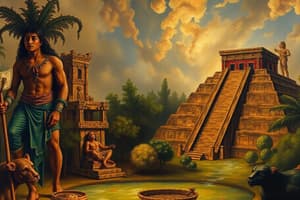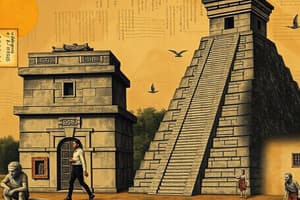Podcast
Questions and Answers
The decline of the Mayan civilization is attributed to what primary environmental factor?
The decline of the Mayan civilization is attributed to what primary environmental factor?
- A sudden ice age that disrupted agricultural cycles.
- Deforestation by neighboring civilizations.
- Increased volcanic activity leading to widespread destruction.
- Over-resourcing leading to draught/flood and overpopulation. (correct)
Which of the following architectural features is most characteristic of Ancient Puebloan settlements?
Which of the following architectural features is most characteristic of Ancient Puebloan settlements?
- Elaborate canal systems for irrigation and transportation.
- Large pyramids dedicated to their rulers.
- Kivas: vents, ladders, sipapu, fireplaces for religious ceremonies and community gatherings. (correct)
- Massive stone heads depicting their rulers.
What was a significant agricultural innovation used by the Aztec civilization to overcome the challenges of building their capital on a lake?
What was a significant agricultural innovation used by the Aztec civilization to overcome the challenges of building their capital on a lake?
- The implementation of a crop rotation system with nitrogen-fixing plants.
- Terraced farming on hillsides to prevent erosion.
- The construction of chinampas, or floating gardens, for food production. (correct)
- The domestication of drought-resistant crops such as cactus and agave.
What factor significantly contributed to the elimination of Rapa Nui's population?
What factor significantly contributed to the elimination of Rapa Nui's population?
What is the main purpose of the Birdman Competition in the Rapa Nui culture?
What is the main purpose of the Birdman Competition in the Rapa Nui culture?
What is the significance of the Jaguar in the Olmec civilization's religion?
What is the significance of the Jaguar in the Olmec civilization's religion?
How did the Inca civilization designate their ruler?
How did the Inca civilization designate their ruler?
Which of the following best describes the social structure of the Aztec civilization?
Which of the following best describes the social structure of the Aztec civilization?
Which of the following is a cultural feature associated with the Mayan Civilization?
Which of the following is a cultural feature associated with the Mayan Civilization?
Which staple crop was deified among the Olmec, Maya, and Aztec civilizations?
Which staple crop was deified among the Olmec, Maya, and Aztec civilizations?
Flashcards
The Olmec Civilization
The Olmec Civilization
First civilization in Mesoamerica known for its art, agriculture, and complex social structure.
The Maya Civilization
The Maya Civilization
Mesoamerican civilization known for its advanced writing system, mathematics, and astronomy.
The Aztec Civilization
The Aztec Civilization
Powerful Mesoamerican empire that controlled a large territory in central Mexico.
The Inca Civilization
The Inca Civilization
Signup and view all the flashcards
Ancient Puebloan Civilization
Ancient Puebloan Civilization
Signup and view all the flashcards
Rapa Nui Civilization
Rapa Nui Civilization
Signup and view all the flashcards
San Lorenzo
San Lorenzo
Signup and view all the flashcards
Tikal
Tikal
Signup and view all the flashcards
Machu Picchu
Machu Picchu
Signup and view all the flashcards
Mesa Verde
Mesa Verde
Signup and view all the flashcards
Study Notes
- The ancient civilizations of the Americas include the Olmec, Maya, Aztec, Inca, Ancient Puebloan, and Rapa Nui.
- The Olmec civilization was located in Mexico, on the south shore of the Gulf and existed from 1300-400 BCE
- The Olmec social structure consisted of priests, rulers, and labourers.
- The Olmecs practiced polytheism and had bird, jaguar, and corn gods linked to rain and farming.
- The Olmecs were known for carving giant heads of rulers and were the first to carve images of their gods and rulers.
- La Venta and San Lorenzo were significant Olmec sites.
The Maya
- The Maya civilization was located in Mexico, Guatemala, Belize, and Honduras and flourished from 300 BCE to 1000 CE.
- The Mayan social structure consisted of city rulers, priests, labourers, and slaves.
- Pacal The Great was a famous Mayan ruler.
- The Maya practiced polytheism and worshipped rain, sun, jaguar, and corn gods.
- Kukulkan was their main god, and Chaac was the rain god.
- Individual city-states characterized the Mayan civilization and included Tikal, Palenque, Chichen Itza, and Uxmal.
- Mayan cities featured temples, plazas, and ball courts.
- Over-resourceing, draught/flood and overpopulation led to decline
- Glyphs were found on fig tree bark
The Aztec
- The Aztec civilization was located in Mexico and existed from 1300-1550 CE.
- The Aztec social structure included a supreme ruler, priests, labourers, and slaves.
- Tenoch and Montezuma were notable Aztec rulers.
- The Aztecs were polytheistic, worshipping rain, sun, and jaguar gods, with Quetzalcoatl as their main god.
- The Aztecs practiced massive human sacrifice.
- Tenochtitlan was built on a lake and featured canal streets and bridges to the mainland.
- Food was grown on chinampas.
- Conquered by Cortes
The Inca
- The Inca civilization was located in Ecuador, Peru, Bolivia, Chile, and Argentina and flourished from 1300-1550 CE.
- The Inca social structure included the Sapa Inka ("Son of Sun God"), friends/relatives, vendors, and prisoners of war.
- Atahualpa and Pachacuti were famous Sapa Inkas.
- The Incas practiced polytheism and worshipped the main Sun God (Inti), a moon goddess, and a thunder god.
- The Inca sites include Sacsayhuaman, Machu Picchu, and Moray and Conquered by Pizarro
Ancient Puebloan
- The Ancient Puebloan civilization was located in the Four Corners region of the American Southwest, including Arizona, Colorado, Utah, and New Mexico, from 450-1400 CE.
- The Ancient Puebloans had no real hierarchy.
- The Ancient Puebloans believed in the Great Spirit and emerged from a lake, taught agriculture and hunting
- The Ancient Puebloans are also known as Anasazi.
- Kivas (vents, ladders, sipapu, fireplaces) were typical structures.
- They moved into cliff dwellings such as Chaco Canyon and Mesa Verde.
- They left because of drought and Navajo invaders, with the Hopi and Zuni people as descendants.
Rapa Nui
- The Rapa Nui civilization was located in the Pacific Ocean, directly west of Ecuador, from 700-1100 CE.
- The Rapa Nui social structure consisted of a Birdman Tribe and other tribes.
- The Rapa Nui civilization centered was based around the Birdman Competition and Frigate bird eggs
- Moai sculptures (depicting ancestors) are a key feature.
- Tribal conflict, deforestation, rats, and disease contributed to their decline.
Studying That Suits You
Use AI to generate personalized quizzes and flashcards to suit your learning preferences.




